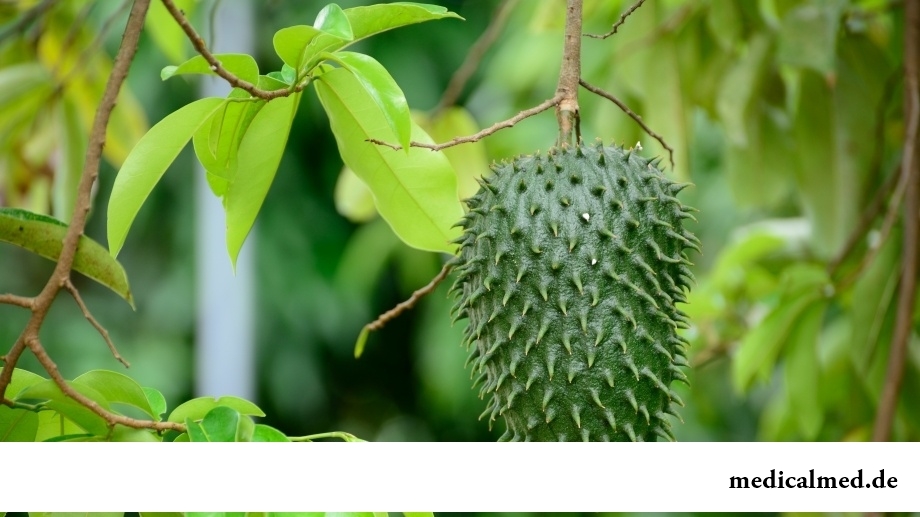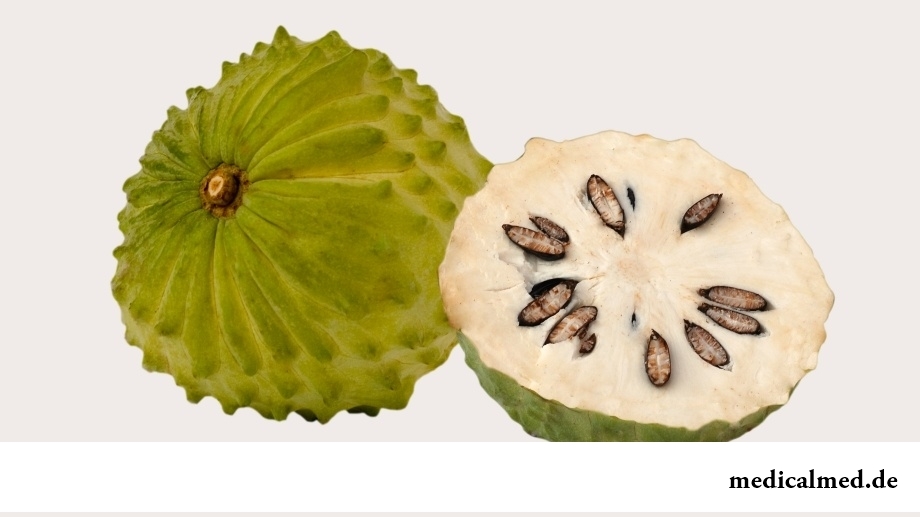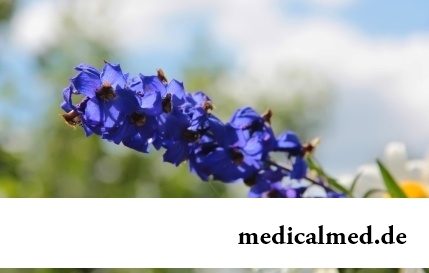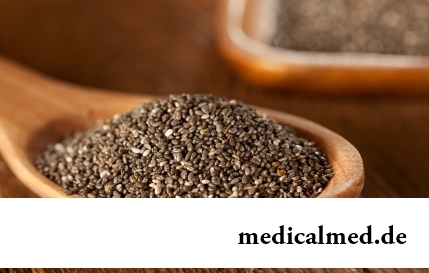





Guanabana
Graviola, smetanny apple, an annon prickly – all this different names of the same tropical fruit plant of a guanabana. Perhaps, in our country it is not so well-known, but it is well known on Bermudas and the Bahamas, it is tasted by residents of Caribbean countries, Latin America. And after inhabitants of other continents estimated taste of this exotic fruit, it began to be grown up in India, Sri Lanka, China, Australia and in Southeast Asia.

Guanabana – a plant more than strange. It is enough to imagine the tree height about the two-storeyed house covered with huge fruits to 35 cm in length and weighing up to 7 kg which cover not only branches, but also a trunk much. And the tree blossoms several times a year, exhaling aroma, comparable with a ylang-ylang and vanilla everywhere. What gastronomic and medicinal properties the guanabana has?
Guanabana fruit outside and inside
In the world of exotics appearance is always deceptive – if you saw a green prickly fruit of smetanny apple, then perhaps would even not count it edible. But, nevertheless, fruits of a guanabana have unique taste and unusual outward. By the sizes they can be compared to an average melon, only unlike it smetanny apple is covered with huge soft thorns. Crude fruits of a guanabana possess a saturated green color and firm pulp, but in process of maturing they turn yellow and become so gentle and soft that are damaged when falling. For this reason they are brought together and sell still unripe. Inexperienced tourists taste fruit right after purchase and are disappointed as the crude fruit of a guanabana on taste is not better than some crude pumpkin. However it is worth allowing to it to ripen at the room temperature as it turns yellow and finds the unique taste. To be convinced that the fruit ripened, press on it a finger – if the surface became soft, smetanny apple can be eaten. In general the fruit of a guanabana can be stored 2-3 days in the refrigerator or at the room temperature, its turned yellow peel can turn black as it happens to mature banana, but pulp at the same time loses the flavoring and useful properties not soon. Inside the mature fruit of a guanabana is covered by the pulp on consistences reminding custard, an internal part of a fruit is divided into several tens of segments, each of which contains the sunflower seed similar to persimmon seeds. It is considered poisonous and usually is removed.
Guanabana, according to gourmets, is cut in half and eat with spoons as grapefruit or cut on segments as a water-melon. If you at least taste once ripe smetanny apple, you will not forget its matchless taste. Comments on the guanabena, to be exact about taste of this fruit, differ a little. One compare it to acid lemonade with a wild strawberry shade, others – with pineapple, strawberry and a citrus. Guanabana – a delicacy quite caloric – 100 g of a crude product have energy value in 94 kcal. But at the same time the guanabana, according to reviews, does not do harm to a figure.
Useful properties of a guanabana
This fruit is not accidentally called smetanny apple – the guanabana is so widespread in tropical America, as well as apples in our latitudes and in addition to pleasant taste possesses rich vitamin mineral composition. Fruits of a guanabana contain sincaline, B2, B5, B6, B9, C, PP vitamins. From microelements concentration of zinc, selenium, copper, manganese, iron, phosphorus, sodium, magnesium, calcium and potassium is highest.
Like apple of our latitudes, smetanny apple of Latin America well affects work of intestines. Useful properties of a guanabana are noted in improvement of work of a liver, normalization of acidity of a stomach, removal of uric acid. It is considered that despite caloric content, smetanny apple promotes weight reduction, and thanks to the high content of vitamins of group B it can be used at complex therapy of degenerative diseases of a backbone and illnesses of the neurologic nature.
Extract of a guanabana has universal antiseptic property, it can be used as antiviral, antimalarial, antifungal and antiparasitic means. And though stones of a guanabana are considered poisonous, the oil received from them is used as natural protivopedikulezny means. Roots of a plant are applied as soothing and anti-spasmodic means, and tea from leaves possesses somnolent action.
Myths about smetanny apple
Recently actively attribute to guanabana fruits anticarcinogenic properties that causes an unhealthy stir around fruits of this tree. According to some information it is considered that extract of smetanny apple destroys malignant cells of 12 types of cancer, including prostate cancer, a breast, lungs, a pancreas, large intestine. Because among useful properties of a guanabana unexpectedly there was an anticarcinogenic effect, in the domestic pharmaceutical market there were various expensive dietary supplements containing extract of these fruits in the structure. However in instructions to such drugs, nothing is told about anticarcinogenic properties, such biological additives are positioned as a source of flavonoids and vitamins.

Of course, as well as any other product, at a guanabana has contraindications. For example, because of the high content of calcium pulp of smetanny apple is not recommended to pregnant women, abuse of fruits, according to the Latin American scientists, can lead to Parkinson's disease. The seeds of this exotic fruit eaten can cause poisoning and if juice from seeds gets into eyes, it can cause in certain cases a blindness.
However, fruits of a guanabana have one wonderful property for certain - it is gentle sweet taste. The mature pulp of a guanabana separated from stones is used in preparation of the desserts in combination with sugar and cream refreshing and low alcohol drinks, and extract is applied to tea aromatization. Anyway, and it is worth trying this surprising fruit.
In the aspiration to pull out the patient, doctors often go too far. So, for example, a certain Charles Janszen during the period from 1954 to 1994 endured more than 900 operations on removal of new growths.

What is in our understanding weeds? It plants which are considered to be suitable only for compost pits and feeding жи...
Section: Articles about health
Frosty air, fresh wind and easy snowball at most of Russians are associated with cheerfulness, health and cheerful entertainments on which our winter is so generous. But, unfortunately, cold season sometimes brings also troubles with health. It is not about a season...
Section: Articles about health
The brain of the person is studied not one hundred years, but the quantity of the riddles connected with this body increases rather, than decreases. Perhaps, numerous delusions concerning a structure and functioning of a brain are explained by it, many of which arose long ago, but continue to exist and today. Such we are ready to acquaint readers with the most widespread myths....
Section: Articles about health
Almost each of us during life faced dissatisfaction with own body. At such moments, as a rule, we beginning...
Section: Articles about health
All got used long ago that, having addressed the plastic surgeon, it is possible to modify natural parameters of a figure or to minimize the damages put to appearance with ruthless time. Many people (preferential women) worldwide е...
Section: Articles about health
Maternal milk is the best food for the newborn. It is the unique natural product containing an optimum set of nutrients, and which is best adapted in order that the baby normally developed and it was protected from harmful factors of external environment, unusual for it. Unfortunately, breastfeeding process not always does without complications. Sometimes, that the kid begins to bite a breast, giving to mother an essential inconvenience. Some women...
Section: Articles about health
The unpleasant feelings connected with spring breakdown are familiar almost to each of us. Often happens that in March-April on the person...
Section: Articles about health
Aspirin (acetylsalicylic acid) – one of those drugs which are known literally to all. It is available in each home first-aid kit, and many accept it at the first signs of an indisposition, often without having a fair idea of properties and a therapeutic eff...
Section: Articles about health
Bathing in broths of medical flowers and plants (phytobathtub) was eurysynusic since Cleopatra who is a good judge in all that concerns beauty and health. And today phytobathtubs is the simple and available means allowing not only to remove nervous tension, but also to recover from many diseases. Grass bathtubs at treatment of cold, osteochondrosis, radiculitis, skin diseases, and also diseases of urinary tract and vessels are especially effective....
Section: Articles about health
One of the useful properties presented to the person by the nature is ability to feel fear. This ability is called a signal...
Section: Articles about health
Phobia – the persuasive fear of a certain contents shown in a specific situation against the will of the person. Concepts of a phobia and fear are similar, however if the fear is natural protective function of mentality, then the phobia is its deviation. So the person can an ispytyva...
Section: Articles about health
All the known slogan "Protect Men!" arose not from scratch. In a sense, the nature created men much less adapted for vital disorders, than it seems at first sight. Statistically, men are ill more often, than women, have the majority of illnesses heavier and earlier die. The situation is aggravated with the fact that our fathers, husbands, brothers and sons are not always inclined to care for the health. Partly it happens because of unwillingness of t...
Section: Articles about health
Extracorporal fertilization – one of the most modern methods of controlling with infertility. So far it already helped znach...
Section: Articles about health
It is impossible to imagine human life in which there would be no plants. Practically in each apartment and any production room there are window plants, millions of people with pleasure are engaged in gardening and truck farming, many citizens пр...
Section: Articles about health
Heart disease and blood vessels lead to disturbance of blood supply of bodies and fabrics that involves failures in their work, deterioration in health of the person, decrease in its working capacity and standard of living. Annually more than 17 million inhabitants of our planet perish from pathologies such....
Section: Articles about health
The name of this disease precisely reflects the problem reason: it consists in the bra fastener pressure upon a certain zone...
Section: Articles about health
The advantage of swimming for the person is so high that this sport is not only the most popular, but also is widely applied in medicine and rehabilitation processes. If you look for for yourself the occupation allowing pleasantly and to spend time, then swimming with advantage...
Section: Slideshow
For the help to doctors in the choice of optimal solutions for treatment of various diseases the Cochrane scientific organization (Cochrane) conducts joint researches with representatives of scientific community around the world. The analysis of a series of the conducted researches of the drug Oscillococcinum® relating to group of cold remedies became one of the last methanolyses....
Section: Articles about health
The cosmetics intended for improvement of a condition of skin, nails and hair are used by each woman. Expenses on регуля...
Section: Articles about health
Energy saving lamps are one of the most popular products of innovative technologies, and there is no wonder: they much more economic also are more long-lasting than usual filament lamps. At the same time there are fears that energy saving bulbs can become the reasons...
Section: Articles about health
The saying "the rich do not know how the other half lives" is known to all. In a broad sense it is that we can not always understand the person whose features of a state are unknown to us. If with physiological characters of diseases the situation is more or less clearly (having noticed them, we realize that to the person nezdorovitsya), then with symptoms of the illnesses affecting the mental sphere everything is much more difficult. Not absolutely usual behavior is quite often perceived surrounding as a ridiculous eccentricity, or that much ху...
Section: Articles about health
There is a lot of fans of beer in our country. Statistically, on each average Russian (including women and children) in...
Section: Articles about health
The sclera and mucous membrane of an eye are intensively supplied with blood vessels which problem - to saturate nervous tissues of body with nutrients and oxygen. In a normality vessels are almost not noticeable, however at their expansion (owing to истонч...
Section: Articles about health
We live during an advertizing era. Daily each person receives a solid portion of persuasive councils about what to eat to be healthy and successful. Products about which we will talk today are combined by the following circumstance: all of them are positioned as the most useful and the most suitable for inclusion in a morning meal. Unfortunately, it is not true: these 10 products do not suit for breakfasts at all....
Section: Articles about health
The chia plant, or the Spanish sage, is from South America. The indigenous people of the continent since ancient times used in food it семена:...
Section: Articles about health
The thought that the mass of their body is too big at least once in life visits from 80 to 95% of women. Many women are so obsessed with this idea that constantly try all new and new ways of weight reduction. Considerable part of these method...
Section: Articles about health
Venereal diseases in medicine are called the infections which are transmitted preferential sexually, now they and are called - infections, sexually transmitted, or STD. Among them is also life-threatening. In spite of the fact that the majority of diseases such will respond to treatment, they are widespread everywhere, and there is no tendency to decrease in incidence. Besides, some of them promptly look younger: statistically, a third of young people at the age of 16-22 years of a str...
Section: Articles about health
